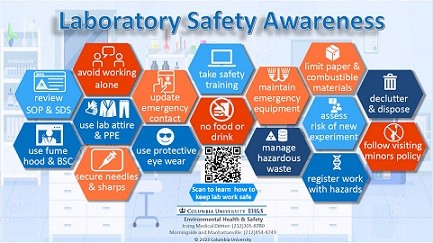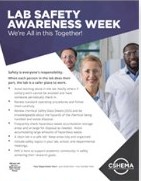Safety Culture
The role of Principal Investigator includes unique responsibilities for supporting the health and safety of laboratory personnel, in addition to their research goals. The 15-minute training module "Principal Investigator Research Safety Responsibilities” (Rascal course TC6800) speaks to these responsibilities. The course is also paired with a brief refresher that is aligned with the goals of the University’s safety culture.
This module is the product of a collaboration with some of the nation’s leading research institutions and peers of Columbia who are fellow members of the Safety Training Consortium. The course contains important reminders about risk assessment, communication, PPE, and other key safety concepts.
Please note, the detailed safety information contained in the existing “Lab Safety, Chemical Hygiene, and Hazardous Waste Management Refresher Training” course is different from the material and messaging of this new course. PIs who themselves work with any types of hazardous materials, or whose laboratories’ work is registered with the IACUC, IBC, RSC or other safety committee, should be current with the University’s existing requirement(s) for laboratory safety training.
Former EVPR Dr. Michael Purdy, Professor Emeritus of Earth and Environmental Sciences, speaks to the issue of research safety (click photo above) (2017)
The term Safety Culture was first introduced by the International Atomic Energy Agency as a result of their analysis of the tragic nuclear reactor accident at Chernobyl:
The Safety Culture of an organization is the product of the individual and group values, attitudes, perceptions, competencies and patterns of behavior that determine the commitment to, and the style and proficiency of, an organization’s health and safety management.
Environmental Health & Safety actively develops partnerships with research laboratories to evaluate, maintain and improve safety culture. Several indicators of a good Safety Culture:
- Visible Management Commitment
- Good Safety Communication
- Safety over Productivity/Profit
- Learning Organization
- High Participation in Safety
- Sufficient Health and Safety Resources
- Low Level of Risk-Taking Practices
- College Laboratory Safety Videos by the American Chemical Society
- Safety in Academic Chemistry Laboratories: Best Practices for First- and Second-Year University Students by the American Chemical Society
- Guidelines to Develop Safety Education for Faculty and Staff in Academic Institutions by the American Chemical Society
- Psychological Safety
- Promoting Safe and Inclusive Research Environments by the Office of Executive Vice President of Research, Columbia University
- Psychological Safety is Lab Safety by the American Chemical Society
Laboratory safety awareness at Columbia University and Affiliates:
Posters

Laboratory Safety Awards and Recognition:
Laboratories at Columbia University and affiliates are encouraged to employ best practices to create a safe research environment:
- Conduct risk assessments for experiments, share standard procedures, keep an up-to-date chemical hygiene plan (LATCH),
- Conduct hands-on training for high-risk experiments,
- Lab members hold C-14 certificate of fitness and emergency contacts are available,
- Routinize open discussions on near misses and incidents at lab meetings,
- Use the EH&S lab safety database LION and other online safety resources,
- Collaborate with other labs on management of shared space and equipment.
Congratulations to the following laboratories that demonstrated outstanding safety practices and received the Safety Champion award and Honorable Mentions:
Safety Champions:
2023: Kevin Bath, Michael Campbell, Alison Pischedda
Honorable Mentions:
2023: Stephen Rayport, Mark Underwood






